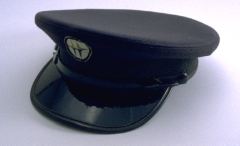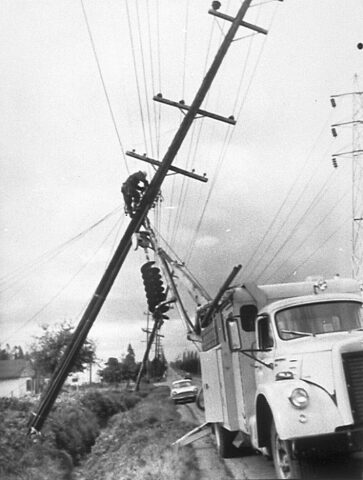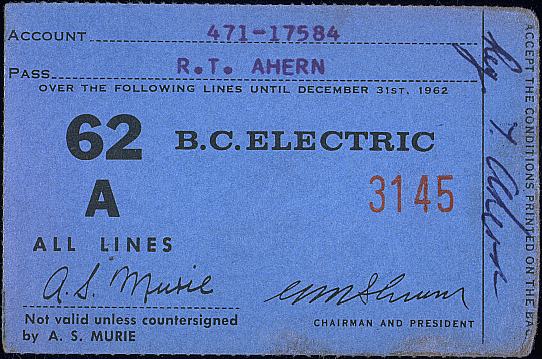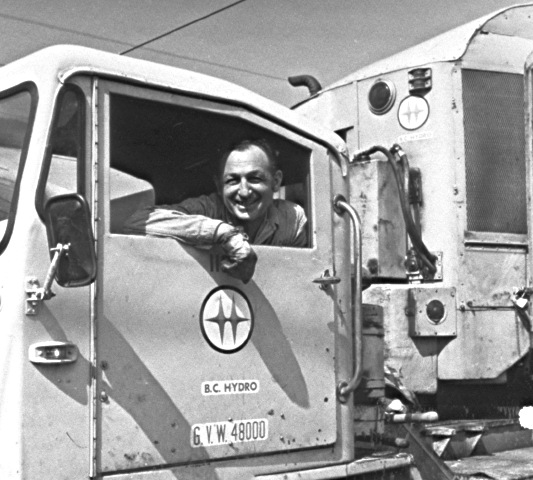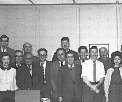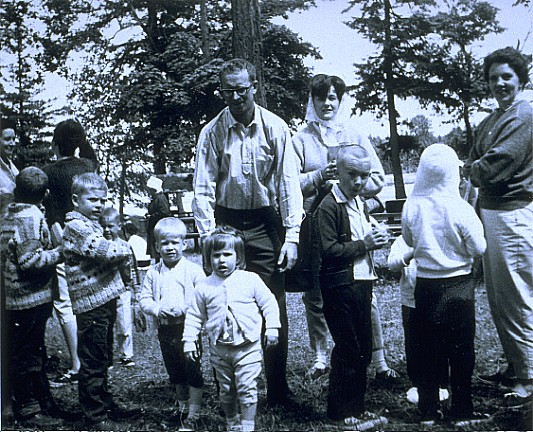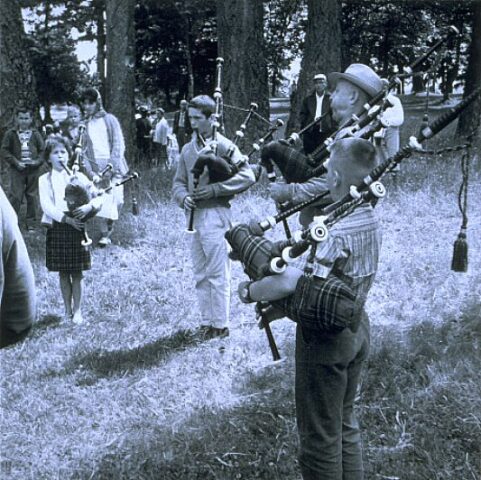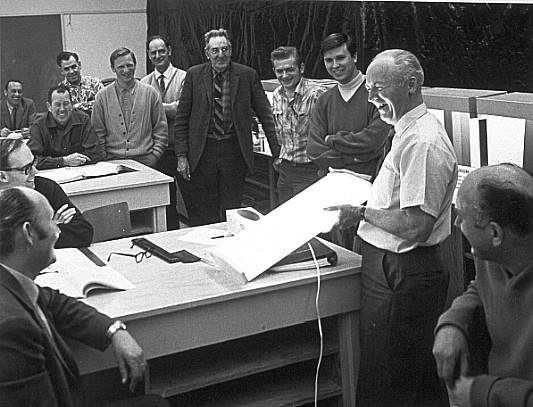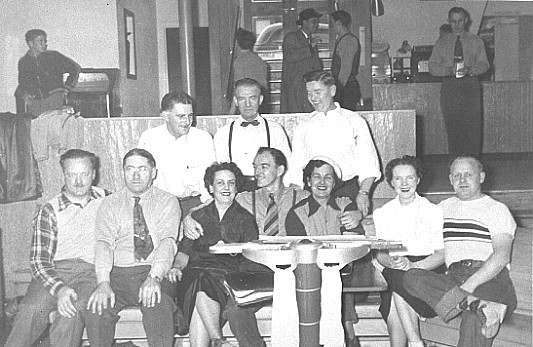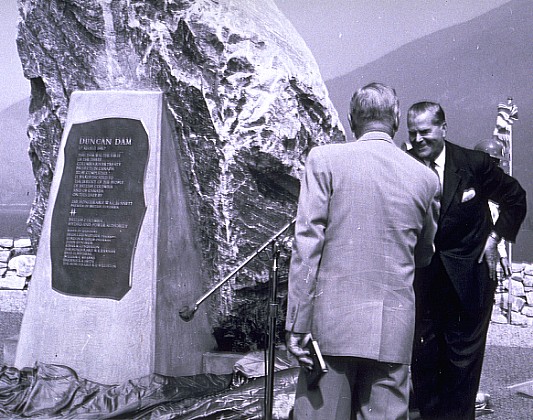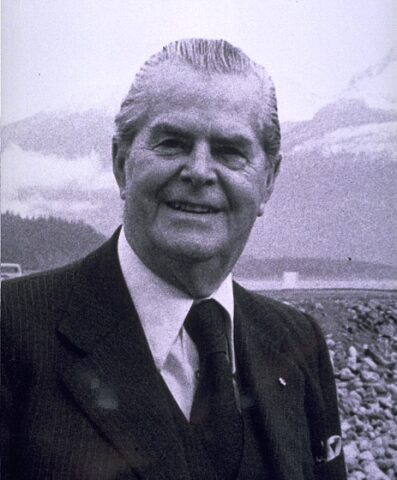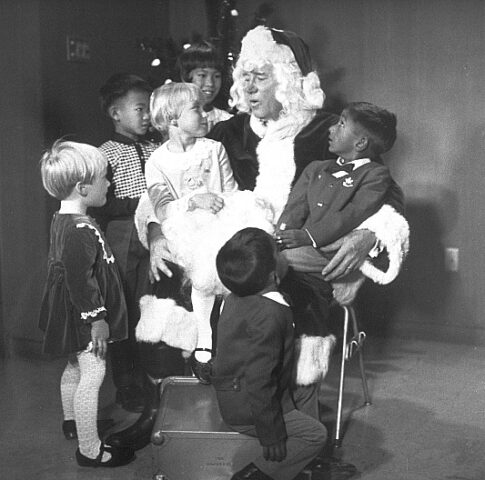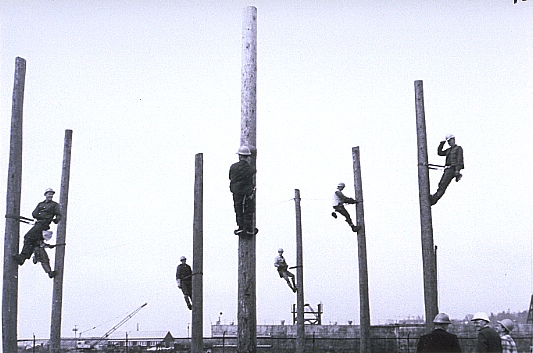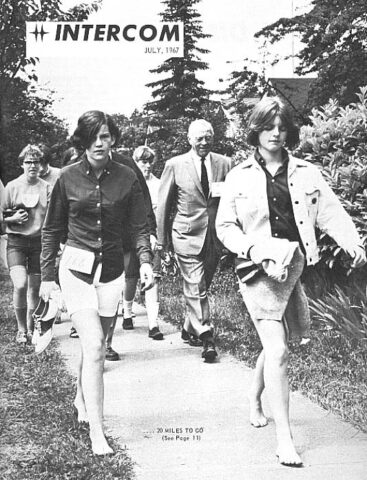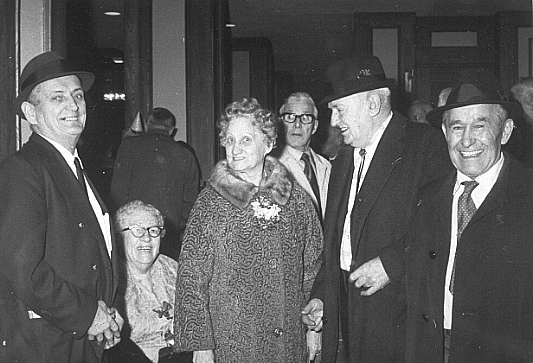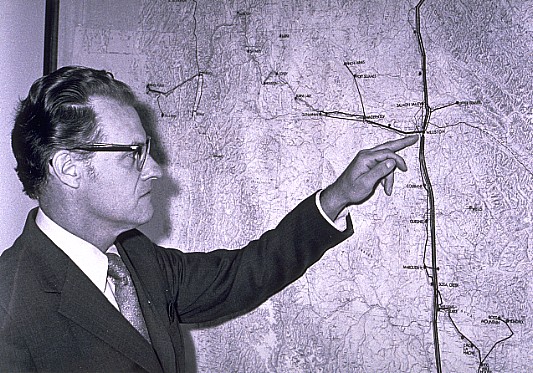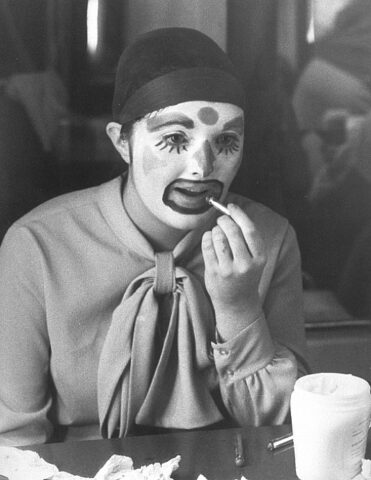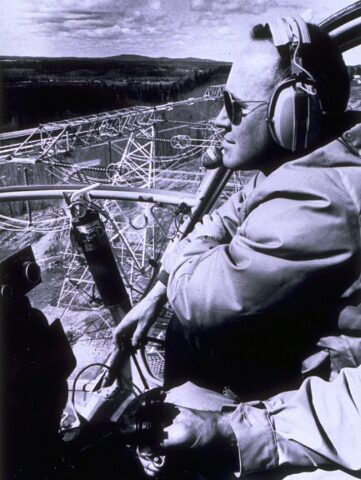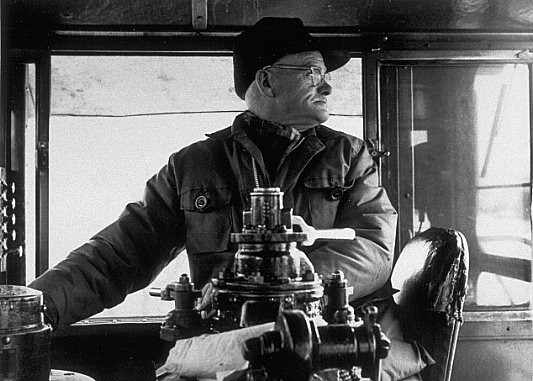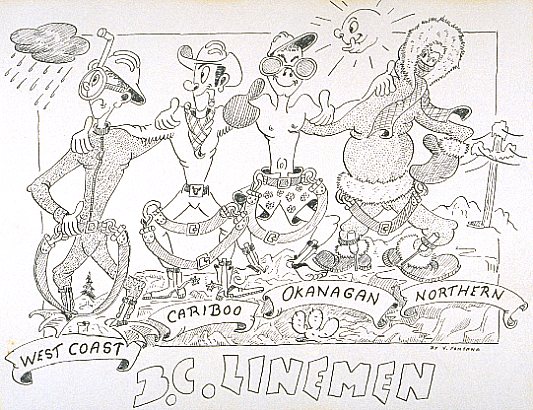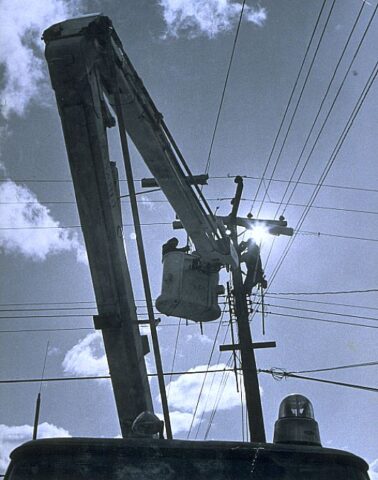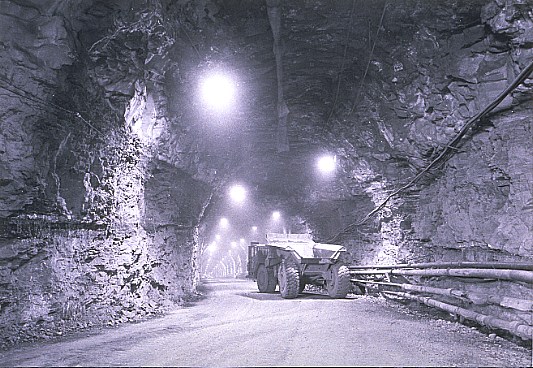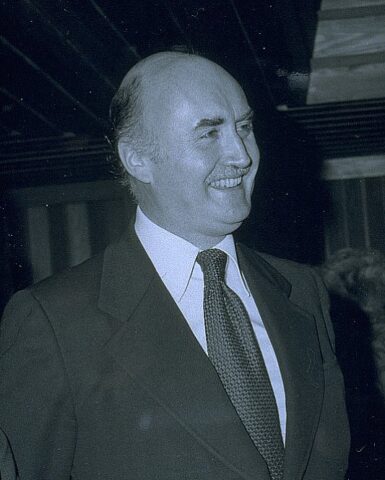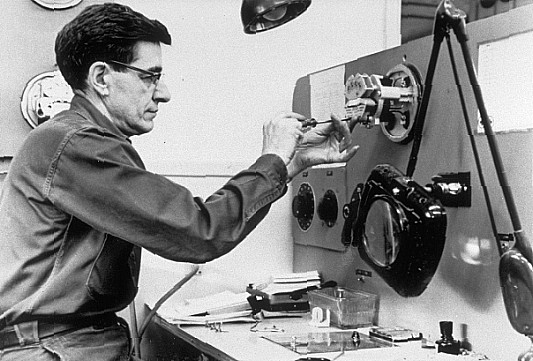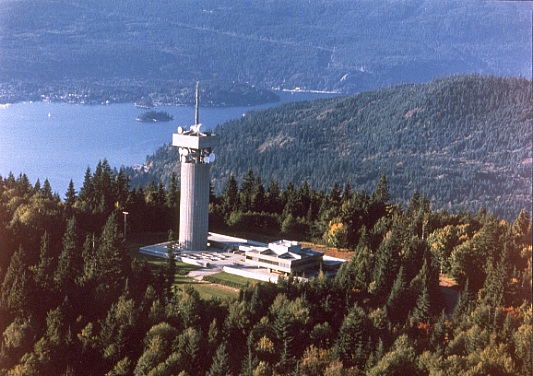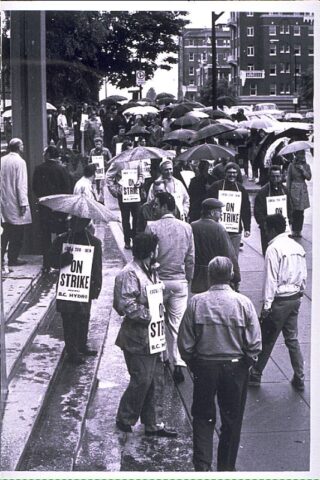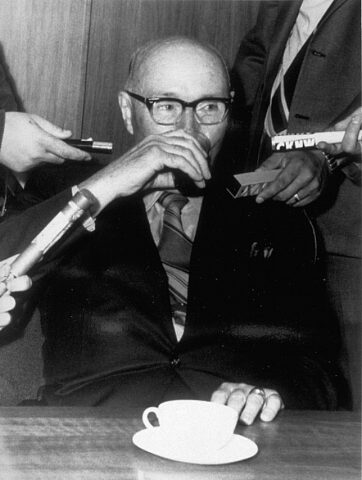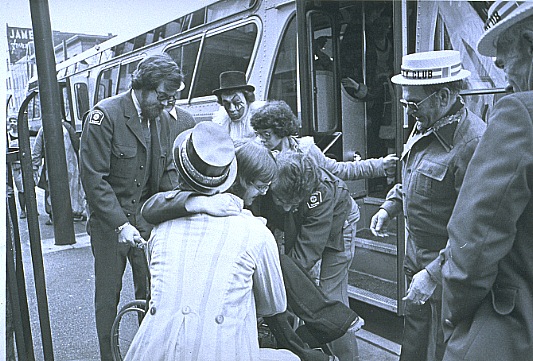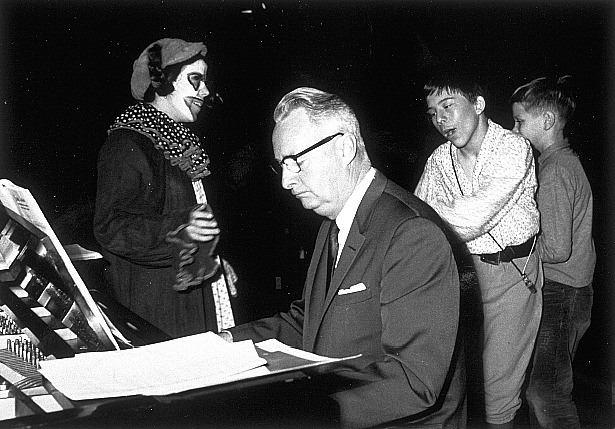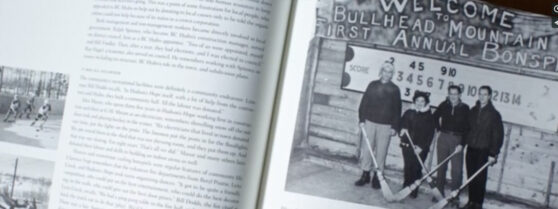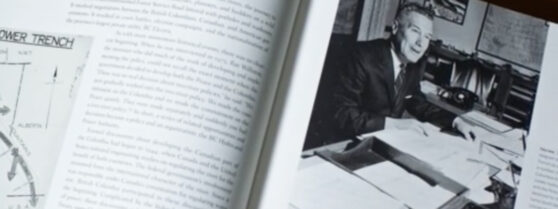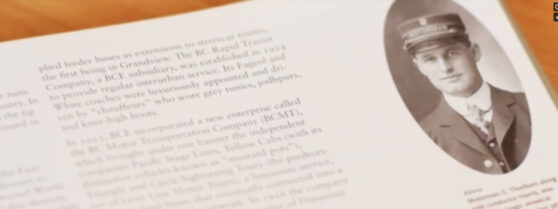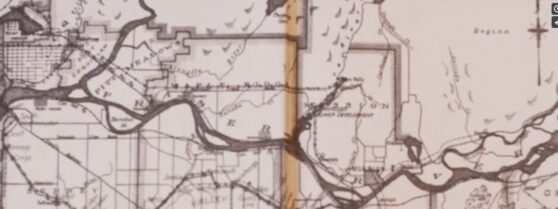Just you
1962-1972
The Politician, the Physicist, and the Diplomat & We Two Are One
The Politician, The Physicist, And The Diplomat
Although he never worked for Hydro or its predecessors, W. A. C. Bennett, the province’s long-ruling premier, had as great an impact on the company as anyone since Francis Barnard and Robert Horne-Payne. Bennett, whom everyone called “Wacky,” combined his vision of the province’s future with a steadfast and sometimes ruthless political will that shaped British Columbia’s history-and with it the physical and economic landscape of the province. BC Hydro was part of that vision. His government’s creation of a new publicly owned utility was marked by the unique and potentially troublesome decision to appoint two men as co-chairs of the organization: Gordon Shrum, head of the BC Energy Board and the Power Commission’s chairman, Hugh Keenleyside.
Norm Olsen of the Power Commission recalls the behind-the-scenes wranglings that preceded the merger.
Dr. Keenleyside began a series of “negotiating” meetings with Dr. Shrum, and each time he returned to Victoria he would tell us what had transpired. We had many ups and downs, good news/bad news stories about division of responsibilities and salary levels because BCE senior salaries were double BCPC salaries-and there were many differences in conditions and benefits.We all anticipated great improve-ments in salary but were in for major disappointments.
One of the first decisions to be made was where Hydro’s head office should be: Vancouver or Victoria. The directors and senior managers were all invited to “vote” and express reasons. By a very close margin, the decision was in favour of Vancouver. As a result, more than 100 Power Commission staff were required to move to Vancouver. On one day about 100 houses went on the market-with a most depressing effect. In my case, it was 13 months before we found a buyer, and the BCPC policy provided no protection against losses or forced sales. It was not a happy time.
Shrum and Keenleyside had extremely different backgrounds and personalities. Shrum was a blunt-spoken physicist who had struck terror into generations of UBC engineering students; Keenleyside, who had also been a UBC academic, was a subtle diplomat who had been Canada’s ambassador to Mexico. Both wrote memoirs that give some insight into their views on the Hydro challenge.
Shrum wrote that he was “not at all happy” when Bennett announced that he and Keenleyside would be joint chairmen.
I thought I was in for a very tough time. Keenleyside had a bigger reputation than I had in Ottawa and around the world, although not in British Columbia, and I knew that he was a clever negotiator and diplomat. I have a very different style: I tend to be abrupt. I did not think we would work well together.
Keenleyside’s views were not much different.
Gordon Shrum and I had started teaching at UBC within a year of each other. We had been on terms of reasonable friendship ever since. I had always admired his determination, his self-confidence, his ingenuity, his lecturing ability and, except in some aspects of his relationship with other human beings, his intelli-gence… When Premier Bennett startled us both by appointing us joint chairmen, I am sure Shrum was deeply incensed. I was dubious about the prospective relationship… Gordon Shrum’s views and mine being on some matters incompatible and our styles and methods of work being so divergent, I entered the new arrangement with some hesitation.
The other big question was how merging the two very different staffs would work. Shrum’s view was typically clear and forceful.
[In] my opinion… the staff of the Power Commission were not nearly as competent as the people at BC Electric. The latter paid higher salaries and had been involved in power generation for many years, building up excellent staff, whereas the Power Commission had not been set up until after the war, when good engineers were in great demand and not many experienced ones would go at a small salary to a little government power commission that boasted only one hydroelectric plant. When the Power Commission staff came to our building, I tried hard to find one department head among them who could be senior to any of ours. Unfortunately I could not; Keenleyside was annoyed to find his own people in second place and I don’t blame him. It was unfortunate: they were very good people but too young and inexperienced.
Keenleyside’s view was more searching and more dispassionate.
BC Electric having been roughly three times the size of BCPC, the managers of its various divisions had directed more subordinates, handled larger sums of money and become more widely known in the business communities of Victoria and Vancouver than had their Commission counterparts. On the other hand, the Commission managers had been responsible for a great variety of duties and had operated under a more flexible system because of the wider geographic areas and the more diversified local conditions within which their work was done. Although even the most senior Commission supervisors were younger and less experienced, they brought greater ardour to their work than some of the BC Electric managers. Neither group was likely to view the prospect of working with the other with lively enthusiasm.
Perhaps it was inevitable that those with greater experience and a record of longer (though not necessarily more important) responsibilities should have been given the higher posts. Thus, most of the BC Electric managers kept their status and most of the Power Commission managers became “associate managers” in the new organization.
In the end, like Shrum, Keenleyside felt that the new arrangements worked out reasonably well.
Gradually, as time passed and experience accumulated, changes occurred, and when I retired in l969 the top posts were about equally divided between managers from the two original organizations.
The different styles of the two chairmen were obvious to anyone who worked for them. Guy Barclay was one of the BC Electric managers who remained in his post.
I liked Shrum. He would come directly to people for answers. He didn’t follow the lines of communication. A typical call from him that I remember: “Your manager at Sechelt is refusing to give someone power. Fire him if necessary.” I went up and checked, and the problem was in Vancouver, not Sechelt. The manager in Sechelt could have been more positive and helped more in this case, but I didn’t fire him.
Keenleyside was different though, in the end, no less formidable. Former BCPC employee Tom Farmer compares the two.
Keenleyside was a very hard man to know. He could be very charming, a real diplomat, no doubt about that. You’d know damn well if you got hit by Shrum. He was very forthright, right out. If he didn’t like someone, he told them. And I got told a couple of times. With Keenleyside it was very subtle. But it was there. You might be bleeding to death before you realized what had happened.
We Two Are One
At the time of the merger, the Power Commission regions were: South Interior, managed by Larry Wight; Central Interior, managed by Stu Burnell; and the Coastal region, managed by Arnold McGillivray. (A fourth region, North Coast, was soon added, managed by Don McLennan.) After the merger, two new regions were added that reflected BC Electric territory: metropolitan Vancouver, headed up by Guy Barclay, and the Fraser Valley managed by Alan Macdonald.
The organizational reconfiguration was the “easy” part. Merging two accomplished and proud sets of employees was another matter. BCPC and BC Electric staff reacted to the merger in countless ways that ranged from shock and sadness to indifference and cynicism. Jack Edwards, who had been a motorman and driver with BC Electric since 1939, took the change in stride.
It didn’t bother me at all because they were both good companies. Those who were on the buses and who stayed kept the same positions when Hydro took over. It didn’t change anything.
Bill Duncan, who was working in BC Electric’s freight division, looks back on the merger with a cool realism.
I was low enough down on the totem pole that I didn’t know what was happening. I wasn’t aware BC Hydro was coming. It came suddenly-although not too suddenly, because senior management people disposed of their shares before the takeover.
There were some changes. People from both organizations who had been in management were gradually eased out. But that part of it wasn’t sudden. Mildred Jeffery of BC Electric was deeply affected by the merger and eventually joined a number of people who chose to leave BC Hydro on principle.
I was a free-enterprise person, and when the company was taken over, well-you can’t write any more as a public relations person. There is a whole different thrust. I spun my wheels for a year and then left. Many top people left. They could see they wouldn’t survive. We all had offers.
I left for philosophical reasons, but I think my term was coming to an end. It was a different company after the merger. My 20 years there were exciting ones-there was so much positive change. It was a growing period, and it was great to see all these new things happening, and to be writing about it was wonderful. To me, the move from 425 Carrall to our beautiful new building was a personal highlight. Now, of course, there is all sorts of talk of privatization at BC Hydro. What goes around comes around.
Ray Flynn of BCE remembers small irritants from the merger such as when he began to work with Max Munro, an extremely popular BCPC manager.
We were not too happy about it. BC Electric was kind of a big family thing, which did things for us that the BC Hydro didn’t. We all got a special rate on the electricity, for instance. They used to put two meters in your house, and you only paid a dollar for all your lights. You only paid for your range and water heater on the meter.
There was a bitterness, particularly in the higher levels. When I moved to my job as a sales rep in Fort St. John in the early 1960s, Max was the district manager there. Now, Max and I have been friends for 30 years, so I can say this now, but at the time, he told me, “I don’t want a sales rep. I wanted a utility man that could work with a crew. But those damn fools down there figure we should have a sales rep.” And he was pretty critical to start with. He was asking me, “Where have you been and what have you done?” In my job, you couldn’t fill in a statistic and say I did this or I did that. You could say, “I’ve been out and I’ve talked to four customers about electric heat.” So he’d ask, “Okay, so what’s happened about it?” Well, I wouldn’t know right then, but six months down the line, three of the four put electric heat in. But you couldn’t report that and say for sure “I got those jobs” or “I sold that.”
Many Power Commission employees watched the merger unfold with a great deal of trepidation. Ted Berger, Russ Hamilton, and Jerry Wills recall finding out that not only were the two companies’ respective management styles very different but so were the union locals.
Russ: We were highly suspicious. That first meeting we had, the coordinator came in and said Hydro was going to close this little shop down. All our stuff was no good. But it wasn’t many months later that they adopted a lot of our methods. One fellow once complained to me, “I thought we took over the Power Commission. Out here it seems like they took over us.”
Ted: There had to be an amalgamation of the union, too, which resulted in the creation of BC Hydro local 258. In Vancouver, 213 was the big one, and 230 in Victoria, but there were not exclusive locals for the companies. There seemed to be a world of difference in the local that served BCE versus the ones at the Power Commission. Common sense prevailed with BCPC, while BCE was pretty militant. They’d had a big strike prior to the Hydro merger.
Jerry: We had an awful job getting along with them. Arnold Keep was running 213 at the time, and they were not happy with the way we operated. We were very easy to get along with and he wasn’t. We had trouble getting together.
Russ: They had a different attitude-strictly union.
Ted: A positive thing about amalgamation was that safety gradually took a more prominent role. BCE safety rules were actually part of the union agreement so it was quite political. At times the Power Commission had hired a bunch of linemen from the prairies and they got people from Saskatchewan and Manitoba who had served good apprenticeships. I think this helped make people realize our training shortcomings. It just got better all the time.
The Power Commission’s Joe West, who had once studied under Shrum, came over from BCPC’s modest Victoria headquarters to work in the construction division. He was based out of Hydro’s head office on Burrard Street in Vancouver.
The beautiful modern glass tower on Burrard Street was a far cry from the old brick building in Victoria and we had a few things to learn. This included all about swivelling, spring office chairs requiring care when leaning back-and about other spring seats in the men’s room. And, most importantly, noting the number of windows in officials’ offices, denoting rank and importance. There was bound to be some ruffled feathers about seniority and about “streamlining” but it only took 20 years or so to work itself out.
Tom Farmer saw the merger at mid-management level and found that the distinct styles of the two organizations made for very different approaches to meetings.
What I could see was that BC Electric was being run by a number of specialists, while the Power Commission was operating out of sort of a general nature. To give you an idea, when we went into Vancouver for meetings over regionalization, four of six regional managers were BC Power Commission men, and the other two were BC Electric background. You went right through all the various functions: cost accounting, building of lines, maintenance of diesels. For each one they [the BC Electric managers] had their own specialists come into the room. If the discussions touched on vehicles, they sent their man into the room and discussed vehicle requirements. If you discussed personnel, their man came into the room and you discussed personnel. Yet the four Commission regional managers were sitting there the whole time, speaking to each of these functions.
One of the pressing issues at Hydro was to create a new logo for the company. When the distinctive logo was unveiled in 1962, many former BC Electric employees bitterly called it “the sign of the double-cross.” Reg Racine of the BCE lighting department has a more light-hearted memory.
I remember a humorous situation at a first meeting where the new six-pointed BC Hydro symbol was introduced. The public relations developer produced a two-page promo document explaining how the two lower blue legs represented the waters of BC and how the two top green legs represented the forests of BC, gas and electricity, the two co-chairmen, et cetera. One perceptive employee remarked that the symbol also represented a bunch of blue people working under two greenhorns. Nevertheless, the symbol proved popular over the years.
The logo, although tweaked a few times over the years, was a remarkably durable one.
Two Rivers, One Company
The 1960’s was a time of larger-than-life leaders and huge projects for BC Hydro. Created to fulfil what could be described as Premier W. A. C. Bennett’s ambitious geopolitical vision of British Columbia as a modern, industrialized society, the new company was overseen by the irrepressible Gordon Shrum and the more understated Hugh Keenleyside. These two powerful characters had a unique co-chairmanship arrangement thrust upon them by Bennett, and in some ways their trials and tribulations personified the company and its employees as they struggled to develop a new personality and mission.
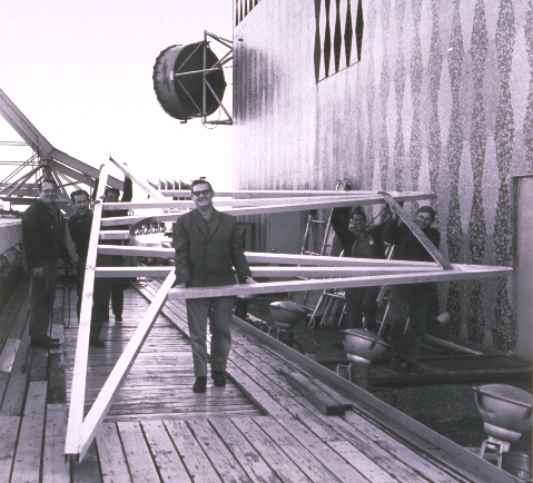
Building staff install the corporate logo atop Hydro headquarters on Burrard Street in 1967. From left: George Williams, Mike Makarenko, Dave Zeron, Joe Gould, Les Baldwin and Nils Baekgaard.
The dams and powerhouses that were started were so big that the new Crown corporation spent the decade scrambling to keep up-with construction schedules, with labour needs, and with the new technology that made such projects possible.
Hydro’s primary goal during the 1960’s was to build electric load and help fulfil Premier W. A. C. Bennett’s desire for more industry. It also aimed to even out the daily and seasonal peaks of power consumption that had bedevilled BC utilities for over a century. Of course, as Hydro generated new hydroelectricity, it also had to respond directly to a rising demand for power.
The company worked to meet customers’ needs by emphasizing higher standards for installations, insulation, equipment performance, and electrical safety. Residential, commercial, and industrial power needs grew during the decade, with demand increasing as high as 17 percent in 1967 from the previous year. Hydro’s marketing strategies were aggressive and highly successful.
This was also the era when environmental concerns came to the forefront of the public agenda. Hydro would now have to respond more fully and publicly to issues of energy conservation and environmental degradation caused by its activities starting in the 1970’s. But, nevertheless, growth was far and away the driving factor during the 1960’s.
Of course the “little things” still had to be attended to: keeping the lights on, the buses running, the freight rolling, and the gas flowing-all of which BC Hydro did admirably. As it turned out, the 1960’s was the last decade during which these traditional businesses, which had been established over the previous hundred years, would function as part of a huge, integrated whole.
